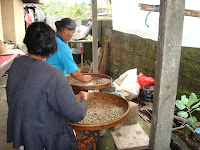This is not what monkey see-monkey do.
location does matter.
In the coffee trade, we speak of a Dry Process and a Washed Process in referring to how the quality of the fruit is judged and the shipments of beans readied for export. While neither the Dry nor the Washed Process is necessarily superior, we at The CV.Bue Janggut have always been partial to the Washed Process for our “CofeRait and Peaberry coffee”. Why? Simple. It's all about taste. Washed coffees tend to have brighter flavors and a cleaner finish.
What follows are de-pulping and fermentation. The cherry shells are mechanically removed, revealing the coffee seeds and go through another round of washing that separates the coffees into varying grades of quality.

when everyone on the business saying about ‘organic’ to get the better positioning and better profit for their products on the market , we try it differently instead. this is about respect for our fellow coffee-growers and our motherland Bali, which offer quality, unique taste, fine aroma, and nice feeling in a cup of coffee.. how they treat the coffee they grow, how they thanks the plants, the earth, divine spirits, and not using toxic agents that harm the environment are might be the right thing worth for support. hence, please use your customers’ right to choose the right one...... thank you
 |
| There is a spiritual dimension to everything in Bali, so twice a year offerings are made and prayers held to bless the coffee that is grown here. |
 |
where the coffee grows will define its aroma and taste. the highland, starting from 400 to 800 meters above the sea level is suitable for robusta, while above 800 to 1,200 meters is the home for arabica. the coffee grown in pupuan highland, tabanan-Bali recognized by its natural cacao taste, since it grows in combination with cacao. careful handling on harvest and processing line would ensure the hygiene and the taste. we taking care into details, including the used veggy oil that we use to fuel the machinery, to avoid air pollution and unwanted odor will be absorbed by the coffee.
In the coffee trade, we speak of a Dry Process and a Washed Process in referring to how the quality of the fruit is judged and the shipments of beans readied for export. While neither the Dry nor the Washed Process is necessarily superior, we at The CV.Bue Janggut have always been partial to the Washed Process for our “CofeRait and Peaberry coffee”. Why? Simple. It's all about taste. Washed coffees tend to have brighter flavors and a cleaner finish.
So what all goes into the Washed Process?
Here's the short version:
Once the coffee cherries are plucked and brought to the washing station, placed in a bath, and washed together. This creates what's called the First Separation as the lighter, less ripe cherries float to the top of the bath while the heavier ones sink to the bottom.
What follows are de-pulping and fermentation. The cherry shells are mechanically removed, revealing the coffee seeds and go through another round of washing that separates the coffees into varying grades of quality.

Next, the beans are dried out in the sun, and taken through a final milling in which the coffee beans are brushed free of the crinkly parchments covering them.
A Density Table gives the beans a good shaking, separating denser, higher quality beans from the less dense, before the beans get their close-ups in front of a trained team of coffee inspectors. The inspectors sort through all the beans - thousands and
thousands - looking for chips, holes, mildew, debris, and color imperfections, and giving a pass only to those beans that pass strict quality control standards. 








Tidak ada komentar:
Posting Komentar